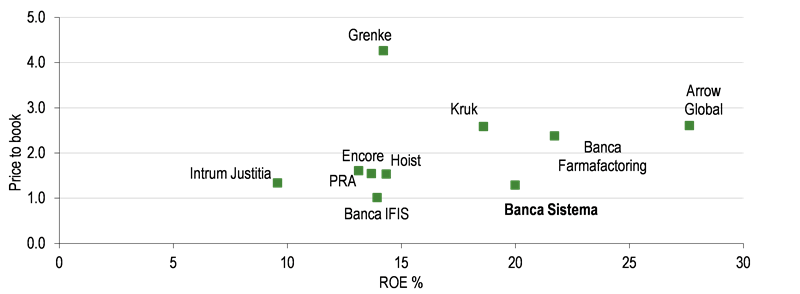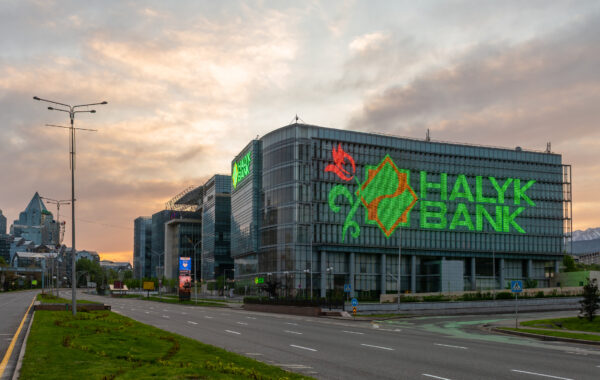H1/Q218 results: In line with expectations
Banca Sistema’s first half results showed healthy growth in factoring turnover, receivables and total banking income, and at the bottom line net earnings increased by 12% over the same period last year. Sequentially, Q218 earnings were 25% ahead of Q118 after adding back a €0.8m TLTRO-related provision in the first quarter.
A longer-term view of the progression of factoring turnover and receivables outstanding is shown in Exhibit 1 confirming the progress that has been made even though seasonality and the incidence of transactions does, unsurprisingly, give rise to some quarterly volatility in turnover.
Exhibit 1: Factoring turnover and receivables outstanding by quarter
|

|
|
|
We have set out a comparison of the H1 and Q2 income statements with the prior year periods in Exhibit 2 and highlight key features below, with percentage changes being for the first half compared with the same period in 2017 unless indicated.
■
Customer loans (excluding government securities) were 45% ahead of the prior year period and up 16% from the FY17 year-end level. The largest contributor to growth in absolute terms was factoring followed by salary and pension-backed lending (CQ). In percentage terms CQ loans saw the most rapid growth (60%), reflecting the group’s positive outlook for this niche area, the potential for a lower risk weighting in FY19 and retention rather than sale of securitised assets. The SME loan book continues to run off and now stands at €40m out of the €2,180m total. Sequentially, Q2 saw an increase of 12% versus Q1.
■
Factoring turnover increased by 29% for the half and for Q218 alone by 33%.
■
Net interest income was up 9%. In practice it is probably more useful to view net interest income and fee income together, because factoring income can fall into either category depending on client preference, and, in total, this measure increased by 16%.
■
Late payment interest in total accounted for 32% of factoring interest (30%).
■
The adjusted interest margin was 4.5% versus 5.4% and, including factoring commission, the margin was 5.2% compared with 6.1%. The reduction mainly reflects a change in mix within factoring with receivables purchased at lower discounts and a higher percentage of tax receivables which have lower risk, longer duration and lower capital absorption.
■
The underlying average gross yield on factoring receivables (interest and commission) ticked up slightly from Q1 (6.9%) to 7.2%.
■
Operating income was 16% ahead and operating expense increased at a slower pace (8%), while normalisation of impairments following a write-back in H117 and a slightly higher tax rate of 34% versus 31% left net income up by 12%.
Exhibit 2: H118/Q218 income statement summary
€000s |
Q217 |
Q218 |
H117 |
H217 |
H118 |
Q218/Q217 % change |
H118/H117 % change |
H118/H217 % change |
Interest and similar income |
21,209 |
24,672 |
37,564 |
49,670 |
44,714 |
16.3 |
19.0 |
-10.0 |
Interest expense and similar charges |
(3,747) |
(5,752) |
(7,679) |
(8,905) |
(12,106) |
53.5 |
57.7 |
35.9 |
Net interest income |
17,462 |
18,920 |
29,885 |
40,765 |
32,608 |
8.3 |
9.1 |
-20.0 |
Net fee and commission income |
2,358 |
3,801 |
4,607 |
6,045 |
7,359 |
61.2 |
59.7 |
21.7 |
Other banking income |
434 |
34 |
665 |
502 |
891 |
-92.2 |
34.0 |
77.5 |
Operating income |
20,254 |
22,755 |
35,157 |
47,312 |
40,858 |
12.3 |
16.2 |
-13.6 |
Net impairment losses on loans |
(1,915) |
(1,852) |
(1,427) |
(3,925) |
(2,939) |
-3.3 |
106.0 |
-25.1 |
Net operating income |
18,339 |
20,903 |
33,730 |
43,387 |
37,919 |
14.0 |
12.4 |
-12.6 |
Personnel expenses |
(4,598) |
(4,796) |
(8,872) |
(8,759) |
(9,560) |
4.3 |
7.8 |
9.1 |
Other administrative expenses |
(4,978) |
(5,934) |
(10,030) |
(9,675) |
(11,005) |
19.2 |
9.7 |
13.7 |
Administrative expenses |
(9,576) |
(10,730) |
(18,902) |
(18,434) |
(20,565) |
12.1 |
8.8 |
11.6 |
Net allowance for risks and charges |
19 |
23 |
(58) |
50 |
(51) |
21.1 |
-12.1 |
-202.0 |
Net adjustments to property and intangible assets |
(153) |
(141) |
(153) |
(150) |
(141) |
-7.8 |
-7.8 |
-6.0 |
Other operating income/costs |
(231) |
48 |
(38) |
(377) |
52 |
-120.8 |
-236.8 |
-113.8 |
Operating expenses |
(9,941) |
(10,800) |
(19,151) |
(18,911) |
(20,705) |
8.6 |
8.1 |
9.5 |
Profit/(loss) from equity investments |
(32) |
(186) |
(32) |
(108) |
(229) |
481.3 |
615.6 |
112.0 |
Profit before tax |
8,366 |
9,917 |
14,547 |
24,368 |
16,985 |
18.5 |
16.8 |
-30.3 |
Tax |
(2,781) |
(3,413) |
(4,564) |
(7,558) |
(5,764) |
22.7 |
26.3 |
-23.7 |
Profit after tax |
5,585 |
6,504 |
9,983 |
16,810 |
11,221 |
16.5 |
12.4 |
-33.2 |
Net interest margin (%) |
4.8 |
3.7 |
4.2 |
4.9 |
3.3 |
|
|
|
Loan loss provision as % of average loans |
0.53 |
0.36 |
0.20 |
0.47 |
0.30 |
|
|
|
Cost income ratio (%) |
47.3 |
47.2 |
53.8 |
39.0 |
50.3 |
|
|
|
Source: Banca Sistema, Edison Investment Research
As far as the balance sheet is concerned, we have highlighted the growth in customer loans above, while the other notable movement in assets was an increase to €436m in the government bond portfolio (from €84m at the year-end). On the liability side of the balance sheet, wholesale funding now accounts for a higher percentage (57% compared with 51% in FY17 and 47% in H117) reflecting repos funding government bonds and a senior bond issue in Q2. The total cost of funding was virtually stable at 0.9% excluding the impact of a €0.8m one-off relating to TLTRO funding that affected Q118. In July Banca Sistema launched a partnership with Deposit Solutions, a platform that gives its clients access to deposit products from a range of banks. This should help broaden Banca Sistema’s deposit base without the need for any additional infrastructure.
Looking at asset quality, the level of bad and unlikely to pay loans as a percentage of customer loans has fallen from 3.1% for Q217 to 2.7% at the end of June. This is similar to the end-FY17 level of 2.6%. The past-due exposure is not relevant here as it is part of normal business in factoring but has also fallen from 5.1% to 4.1%, most likely reflecting the growth in CQ business.
The Q218 CET1 ratio was 11% and total capital ratio 14.1%, which compares with 11.8% and 15% at the end of Q118. The increased volatility in bond markets during Q2 resulted in a valuation reserve (c €2m, taken straight to the balance sheet), which had a small, 18bp, impact on the CET ratio. The ratios are well above the Bank of Italy minima set at 7.125% for CET1 and 11.225% for the total capital ratio.














